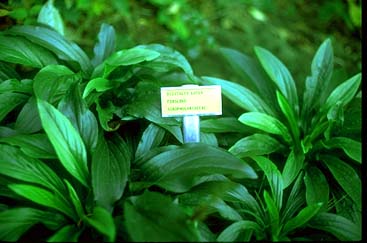Digitalis purpurea (Foxglove)
[Description] [Range] [Toxic Agent] [Return to Cardiac Glycosides] [Return to list of toxicants]
Description

Foxglove is a bienneial plant with soft, hairy, toothed, ovate and lance-shaped leaves in a basal rosette. The life span of the plant is 2 seasons. The first year growth remains in a basal rosette of leaves. Second year growth produces flowering stems, 3 -6 feet in height. Flower spikes have purple to white spotted thimble-like flowers which hang down and last about six days. The earliest known name for this plant is the Anglo-Saxon "foxes glofa" (the glove of the fox). It derives its name from the flowers which resemble the fingers of a glove and possibly from a northern legend that bad fairies gave the blossoms to the fox to put on his toes, so that he might soften his tread while he hunted for prey. First year growth has been mistaken for Comfrey (Symphitum officinale) with fatal results. Although, ingestion of this plant can be fatal at any time during the life of the plant, it is most toxic just before the seeds ripen. The upper leaves of the stem are also more toxic than the lower leaves.
Range

Native to Europe, this plant is widly cultivated. It is a common garden escape and is naturalized in the U.S. Pacific Northwest. It thrives in siliceous or loam soil, but needs very little soil to survive. It is often found in the crevices of granite walls, dry hilly pastures, roadsides, logged-off areas, and rocky places.
Toxic Agent
Many of the common names of this plant pertain to its toxic nature (Witches' glove, Dead Man's Bells, Bloody Fingers). Foxglove belongs to the Figwort family (Scrophulariaceae) and the whole plant is toxic. It contains various cardiac glycosides. Symptoms include dizziness, vomiting, irregular heart beat, and delerium or halucinations.
Digitonin is a Digitalis drug derived from D. purpurea. It is used in modern medicine to increase the force of the systolic contractions and prolong duration of the diastolic phase in congestive heart failure. Digitalis drugs lower venous pressure in hypersensetive heart ailments, elevate blood pressure in a weak heart act as a diuretic, and reduce edema. However, the theraputic dose is dangerously close to the lethal dose. Historically, Foxglove was employed by herbalists for a variety of purposes, from an ointment used for cleansing wounds and reducing swelling to boiling it and using it as an expectorant.
There are a number of plants containing glycosides (including Lily of the Valley), which are toxic to a wide range of animals including humans.
More information describing Foxglove is available under the listing for Digitalis purpurea, Foxglove, in the Canadian Poisonous Plants Information System, courtesy of Derek B. Munro.